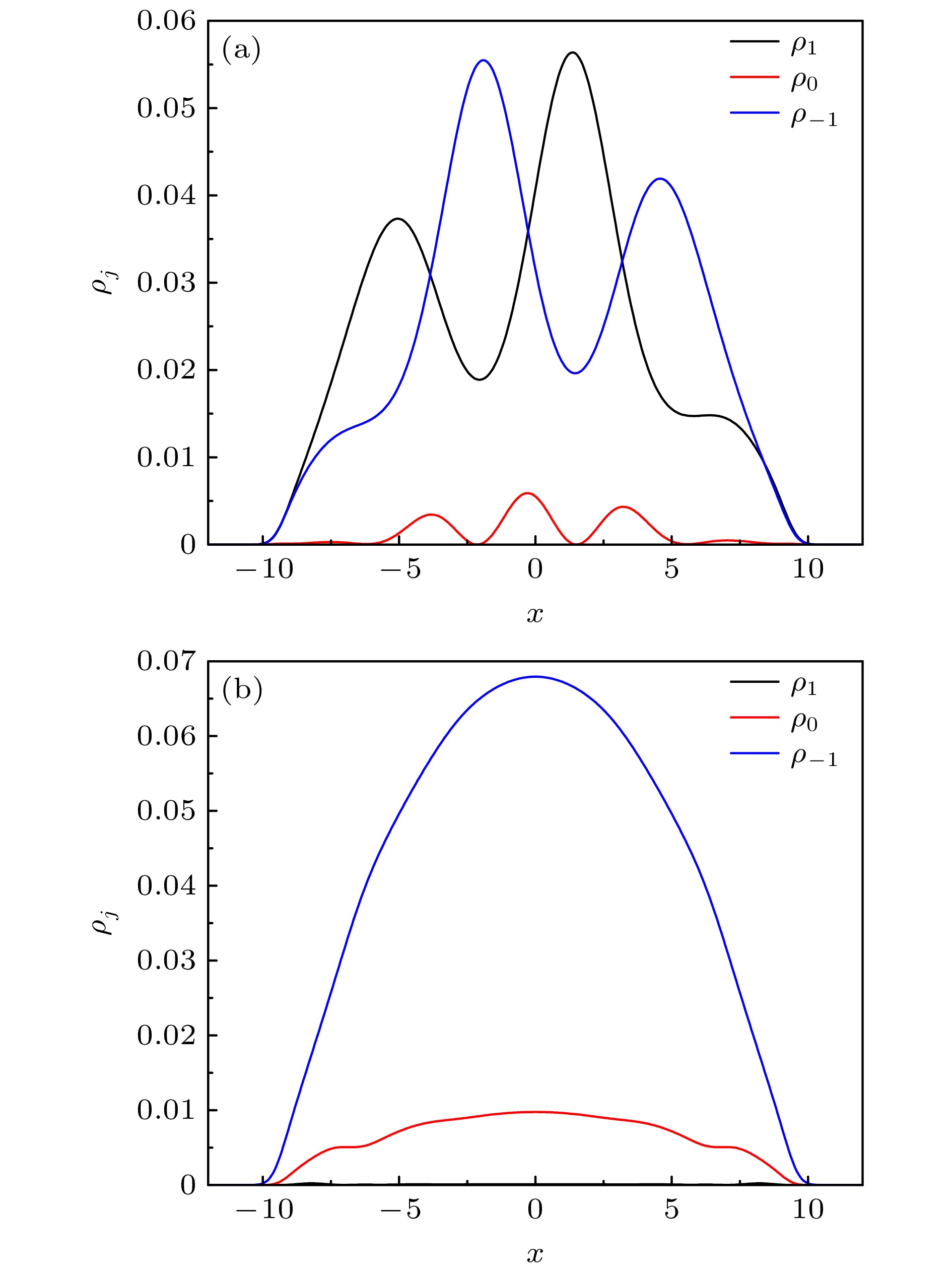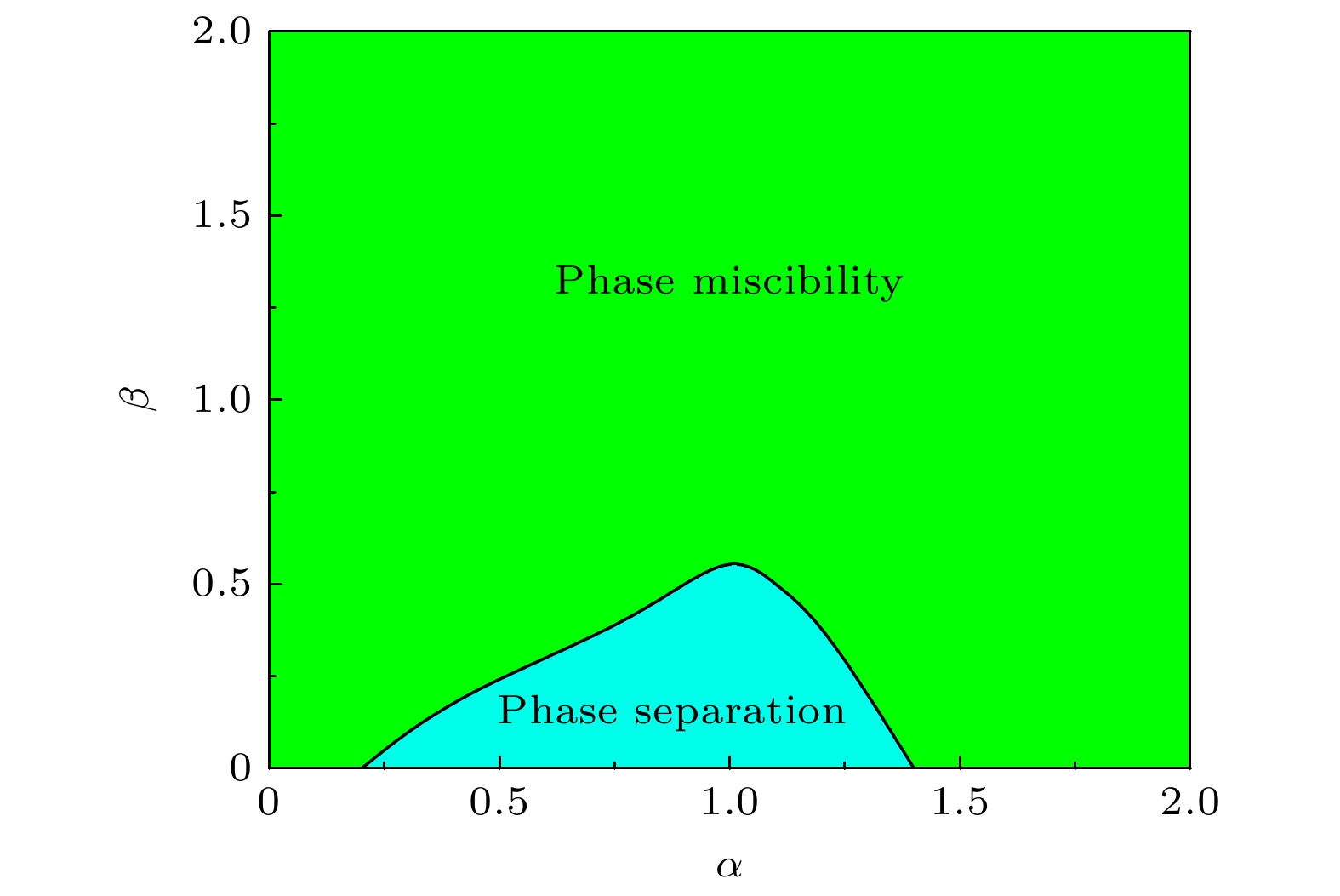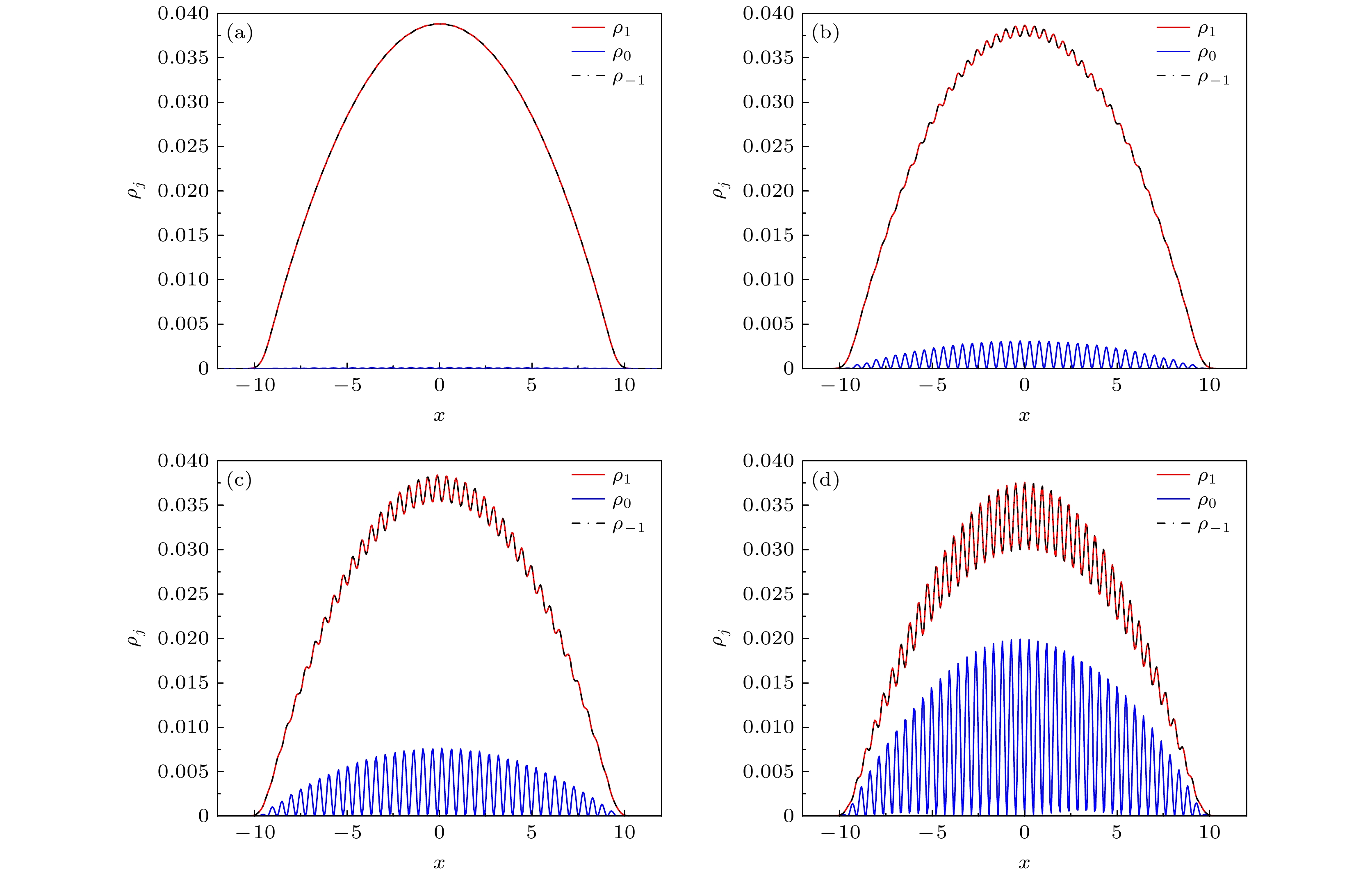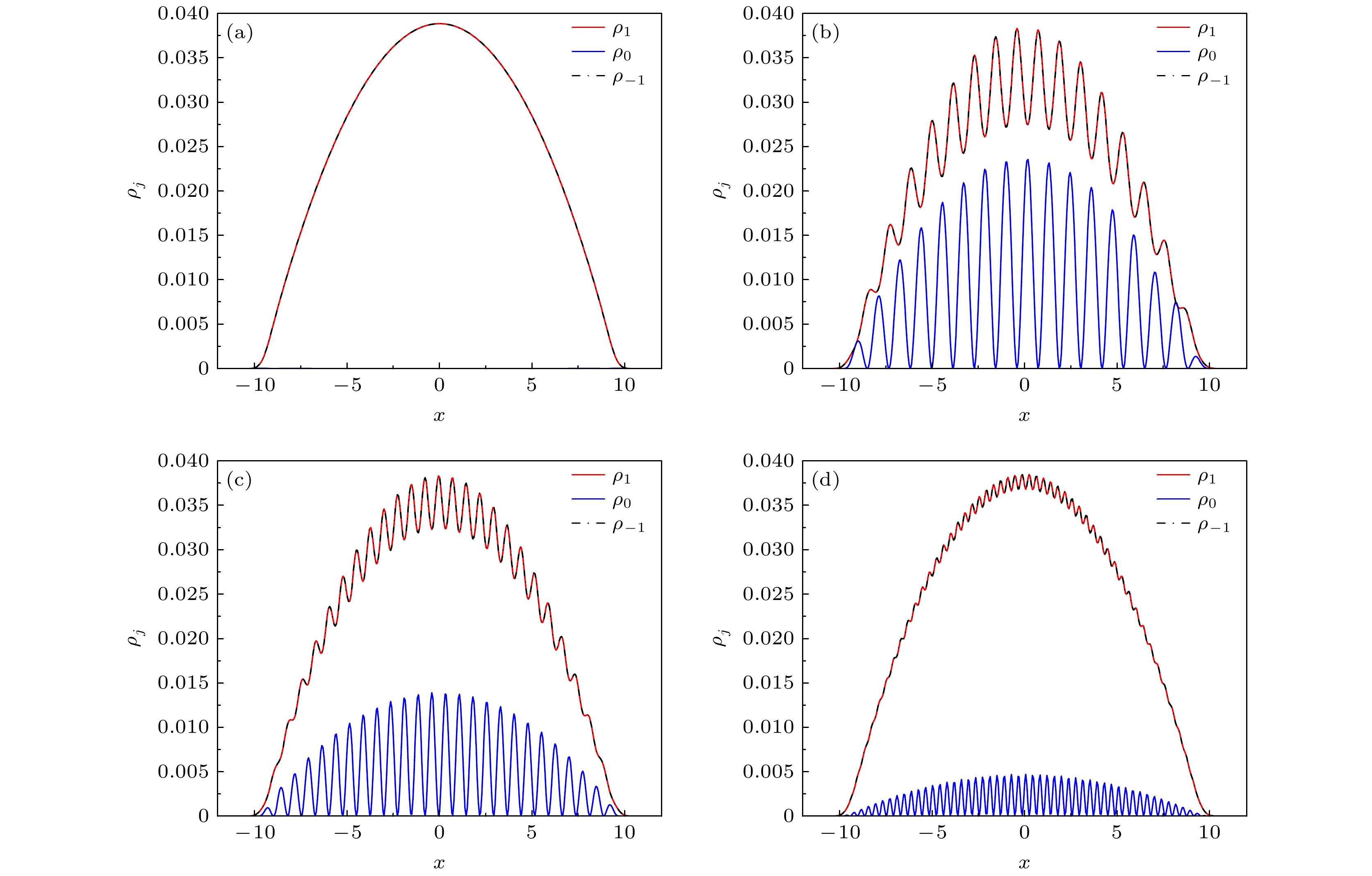-
The spinor Bose-Einstein condensate (BEC) provides an ideal platform for observing and manipulating topological structures, which arise from the spin degrees of freedom and the superfluid nature of the gas. Artificial helicoidal spin-orbit coupling (SOC) in the spinor BEC, owing to the spatially varying gauge potential and the more flexible adjustability, provides possibly an unprecedented opportunity to search for novel quantum states. The previous studies of the BEC with helicoidal SOC mainly focus on the two-component case. However, there are few reports on the studies of helicoidal SOC in three-component BEC. Especially considering one-dimensional three-component BEC, whether the helicoidal SOC can generate previously unknown types of topological excitations and phase diagrams is still an unsolved problem. In this work, by solving quasi one-dimensional Gross-Pitaevskii equations, we study the ground state structure of one-dimensional helicoidal spin-orbit coupled three-component BEC. The numerical results show that the helicoidal SOC can induce a phase separation among the components in ferromagnetic BEC. Through numerical calculations of the system, a phase diagram is obtained as a function of the helicoidal SOC strength and gauge potential, which shows the critical conditions for phase separation and phase miscibility in ferromagnetic BEC. Meanwhile, we also study the influences of the helicoidal SOC and the gauge potential on the antiferromagnetic BEC ground state. The numerical results show that the helicoidal SOC is beneficial for the miscibility in antiferromagnetic BEC. When the helicoidal SOC strength or gauge potential increases, the ground state of antiferromagnetic BEC exhibits a stripe soliton structure. Adjusting the strength of helicoidal SOC or gauge potential can control the transitions between a plane-wave soliton and a stripe soliton. In addition, we show the changes of the particle number density maximum and the number of peaks of stripe solitons for adjusting the helicoidal SOC strength or gauge potential. Our results show that helicoidal spin-orbit coupled BEC not only provides a controlled platform for investigating the exotic topological structures, but also is crucial for the transitions between different ground states. This work paves the way for exploring the topological defect and the corresponding dynamical stability in quantum systems subjected to the helicoidal SOC in future.
-
Keywords:
- three-component Bose-Einstein condensate /
- helicoidal spin-orbit coupling /
- phase separation /
- phase miscibility
[1] Ho T L 1998 Phys. Rev. Lett. 81 742
 Google Scholar
Google Scholar
[2] Stamper-Kurn D M, Ueda M 2013 Rev. Mod. Phys. 85 1191
 Google Scholar
Google Scholar
[3] Mizushima T, Machida K, Kita T 2002 Phys. Rev. A 66 053610
 Google Scholar
Google Scholar
[4] Martikainen J P, Collin A, Suominen K A 2002 Phys. Rev. A 66 053604
 Google Scholar
Google Scholar
[5] Mizushima T, Kobayashi N, Machida K 2004 Phys. Rev. A 70 043613
 Google Scholar
Google Scholar
[6] Li L, Li Z D, Malomed B A, Mihalache D, Liu W M 2005 Phys. Rev. A 72 033611
 Google Scholar
Google Scholar
[7] Ji A C, Liu W M, Song J L, Zhou F 2008 Phys. Rev. Lett. 101 010402
 Google Scholar
Google Scholar
[8] Seo S W, Kang S J, Kwon W J, Shin Y 2015 Phys. Rev. Lett. 115 015301
 Google Scholar
Google Scholar
[9] Seo S W, Kwon W J, Kang S J, Shin Y 2016 Phys. Rev. Lett. 116 185301
 Google Scholar
Google Scholar
[10] Orlova N V, Kuopanportti P, Milošević M V 2016 Phys. Rev. A 94 023617
 Google Scholar
Google Scholar
[11] Kim K, Hur J, Huh S J, Choi S, Choi J Y 2021 Phys. Rev. Lett. 127 043401
 Google Scholar
Google Scholar
[12] Li S X, Saito H 2024 Phys. Rev. Res. 6 L042049
 Google Scholar
Google Scholar
[13] Ros A R, Katsimiga G C, Mistakidis S I, et al. 2024 Phys. Rev. Lett. 132 033402
 Google Scholar
Google Scholar
[14] Ray M W, Ruokokoski E, Kandel S, Möttönen M, Hall D S 2014 Nature 505 657
 Google Scholar
Google Scholar
[15] Ray M W, Ruokokoski E, Tiurev K, Möttönen M, Hall D S 2015 Science 348 544
 Google Scholar
Google Scholar
[16] Lin Y J, Jiménez-García K, Spielman I B 2011 Nature 471 83
 Google Scholar
Google Scholar
[17] Ji S C, Zhang J Y, Zhang L, Du Z D, Zheng W, Deng Y J, Zhai H, Chen S, Pan J W 2014 Nat. Phys. 10 314
 Google Scholar
Google Scholar
[18] Wu Z, Zhang L, Sun W, Xu X T, Wang B Z, Ji S C, Deng Y J, Chen S, Liu X J, Pan J W 2016 Science 354 83
 Google Scholar
Google Scholar
[19] Huang L H, Meng Z M, Wang P J, Peng P, Zhang S L, Chen L C, Li D H, Zhou Q, Zhang J 2016 Nat. Phys. 12 540
 Google Scholar
Google Scholar
[20] Anderson B M, Juzeliúnas G, Galitski V M, Spielman I B 2012 Phys. Rev. Lett. 108 235301
 Google Scholar
Google Scholar
[21] Mithun T, Fritsch A R, Koutsokostas G N, Frantzeskakis D J, Spielman I B, Kevrekidis P G 2024 Phys. Rev. A 109 023328
 Google Scholar
Google Scholar
[22] 文林, 梁毅, 周晶, 余鹏, 夏雷, 牛连斌, 张晓斐 2019 物理学报 68 080301
 Google Scholar
Google Scholar
Wen L, Liang Y, Zhou J, Yu P, Xia L, Niu L B, Zhang X F 2019 Acta Phys. Sin. 68 080301
 Google Scholar
Google Scholar
[23] Gautam S, Adhikari S K 2014 Phys. Rev. A 90 043619
 Google Scholar
Google Scholar
[24] Wang C J, Gao C, Jian C M, Zhai H 2010 Phys. Rev. Lett. 105 160403
 Google Scholar
Google Scholar
[25] Liu C F, Liu W M 2012 Phys. Rev. A 86 033602
 Google Scholar
Google Scholar
[26] 李吉, 刘斌, 白晶, 王寰宇, 何天琛 2020 物理学报 69 140301
 Google Scholar
Google Scholar
Li J, Liu B, Bai J, Wang H Y, He T C 2020 Acta Phys. Sin. 69 140301
 Google Scholar
Google Scholar
[27] Sinha S, Nath R, Santos L 2011 Phys. Rev. Lett. 107 270401
 Google Scholar
Google Scholar
[28] Hu H, Ramachandhran B, Pu H, Liu X J 2012 Phys. Rev. Lett. 108 010402
 Google Scholar
Google Scholar
[29] 李吉, 刘伍明 2018 物理学报 67 110302
 Google Scholar
Google Scholar
Li J, Liu W M 2018 Acta Phys. Sin. 67 110302
 Google Scholar
Google Scholar
[30] Han W, Juzeliūnas G, Zhang W, Liu W M 2015 Phys. Rev. A 91 013607
 Google Scholar
Google Scholar
[31] Li J, Yu Y M, Zhuang L, Liu W M 2017 Phys. Rev. A 95 043633
 Google Scholar
Google Scholar
[32] Li J, Zhang X F, Liu W M 2018 Ann. Phys. 396 87
 Google Scholar
Google Scholar
[33] Kartashov Y V, Konotop V V 2017 Phys. Rev. Lett. 118 190401
 Google Scholar
Google Scholar
[34] Yang Y X, Gao P, Wu Z Y, Zhao L C, Yang Z Y 2021 Annals of Physics 431 168562
 Google Scholar
Google Scholar
[35] Yang Y X, Gao P, Zhao L C, Yang Z Y 2022 Front. Phys. 17 32503
 Google Scholar
Google Scholar
[36] Li X X, Cheng R J, Ma J L, Zhang A X, Xue J K 2021 Phys. Rev. E 104 034214
 Google Scholar
Google Scholar
[37] Fang P P, Lin J 2024 Phys. Rev. E 109 064219
 Google Scholar
Google Scholar
[38] Kartashov Y V, Sherman E Y, Malomed B A, Konotop V V 2020 New J. Phys. 22 103014
 Google Scholar
Google Scholar
[39] Li X X, Cheng R J, Ma J L, Zhang A X, Xue J K 2019 Phys. Rev. E 100 032220
 Google Scholar
Google Scholar
[40] Otlaadisa P, Tabi C B, Kofané T C 2021 Phys. Rev. E 103 052206
[41] Fang P P, He J T, Asgari R, Gao X L, Lin J 2023 Eur. Phys. J. Plus 138 482
 Google Scholar
Google Scholar
[42] Chen Y X 2023 Optik - International Journal for Light and Electron Optics 276 170685
 Google Scholar
Google Scholar
[43] Zhang D C, Yang S J 2024 Physica B 674 415528
 Google Scholar
Google Scholar
[44] Rechtsman M C, Zeuner J M, Plotnik Y, et al. 2013 Nature 496 196
 Google Scholar
Google Scholar
[45] Jiménez-García K, LeBlanc L J, Williams R A, et al. 2015 Phys. Rev. Lett. 114 125301
 Google Scholar
Google Scholar
[46] Luo X Y, Wu L N, Chen J Y, Guan Q, Gao K Y, Xu Z F, You L, Wang R Q 2016 Sci. Rep. 6 18983
 Google Scholar
Google Scholar
[47] Bao W Z, Chern I L, Lim F Y 2006 J. Comput. Phys. 219 836
 Google Scholar
Google Scholar
[48] Chiquillo E 2018 Phys. Rev. A 97 013614
 Google Scholar
Google Scholar
[49] Tononi A, Wang Y M, Salasnich L 2019 Phys. Rev. A 99 063618
 Google Scholar
Google Scholar
[50] Matuszewski M, Alexander T J, Kivshar Y S 2009 Phys. Rev. A 80 023602
 Google Scholar
Google Scholar
[51] Zhao L C, Luo X W, Zhang C W 2020 Phys. Rev. A 101 023621
 Google Scholar
Google Scholar
[52] Saboo A, Halder S, Das S, Majumder S 2024 Phys. Rev. A 110 033325
 Google Scholar
Google Scholar
[53] 张瑞芳, 李禄 2020 量子光学学报 26 33
Zhang R F, Li L 2020 J. Quantum Opt. 26 33
[54] Petrov D S 2015 Phys. Rev. Lett. 115 155302
 Google Scholar
Google Scholar
[55] Petrov D S, Astrakharchik G E 2016 Phys. Rev. Lett. 117 100401
 Google Scholar
Google Scholar
-
图 1 不同螺旋自旋-轨道耦合强度下铁磁BEC基态, 3个自旋分量的粒子数密度$ {\rho _1} $, $ {\rho _0} $和$ {\rho _{ - 1}} $分别用黑线、红线和蓝线表示 (a) $ \alpha = 0.15 $; (b) $ \alpha = 0.8 $; 其他模拟参数$ \beta = 0.4 $, $ {\lambda _0} = 600 $, $ {\lambda _2} = - 2.76 $
Figure 1. Ground state of the ferromagnetic BEC for different helicoidal spin-orbit coupling strengths, the particle number densities $ {\rho _1} $, $ {\rho _0} $ and $ {\rho _{ - 1}} $ for the three spin components are depicted by black, red, and blue lines, respectively: (a) $ \alpha = 0.15 $; (b) $ \alpha = 0.8 $; the rest of parameters are $ \beta = 0.4 $, $ {\lambda _0} = 600 $, $ {\lambda _2} = - 2.76 $.
图 2 不同螺旋规范势下铁磁BEC基态, 3个自旋分量的粒子数密度$ {\rho _1} $, $ {\rho _0} $和$ {\rho _{ - 1}} $分别用黑线、红线和蓝线表示(a) $ \beta = 0.2 $; (b) $ \beta = 0.8 $; 其余模拟参数$ \alpha = 1 $, $ {\lambda _0} = $$ 600 $, $ {\lambda _2} = - 2.76 $
Figure 2. Ground state of the ferromagnetic BEC for different helicoidal gauge potentials, the particle number densities $ {\rho _1} $, $ {\rho _0} $and $ {\rho _{ - 1}} $ for the three spin components are depicted by black, red, and blue lines, respectively: (a) $ \beta = 0.2 $; (b) $ \beta = 0.8 $; the rest of parameters are $ \alpha = 1 $, $ {\lambda _0} = 600 $, $ {\lambda _2} = - 2.76 $.
图 3 螺旋自旋-轨道耦合铁磁BEC基态相图, 包括相混合和相分离, 其余模拟参数选为$ {\lambda _0} = 600 $, $ {\lambda _2} = - 2.76 $
Figure 3. Phase diagram of the ground state of the ferromagnetic BEC with the helicoidal spin-orbit coupling, the phase diagram includes phase miscibility and phase separation, the other parameters are $ {\lambda _0} = 600 $, $ {\lambda _2} = - 2.76 $.
图 4 (a) 当螺旋自旋-轨道耦合强度$ \alpha $确定时, 粒子数密度$ {\rho _0} $最大值随螺旋规范势$ \beta $的变化; (b) 当螺旋规范势$ \beta $确定时, 粒子数密度$ {\rho _0} $最大值随螺旋自旋-轨道耦合强度$ \alpha $的变化; 其余模拟参数$ {\lambda _0} = 600 $, $ {\lambda _2} = - 2.76 $
Figure 4. (a) The particle number density $ {\rho _0} $maximum as a function of helicoidal gauge potential for a given helicoidal spin-orbit coupling strength; (b) the particle number density $ {\rho _0} $ maximum as a function of helicoidal spin-orbit coupling strength for a given helicoidal gauge potential parameter; the other parameters are $ {\lambda _0} = 600 $, $ {\lambda _2} = - 2.76 $.
图 5 不同螺旋自旋-轨道耦合强度下反铁磁BEC基态, 3个自旋分量的粒子数密度$ {\rho _1} $, $ {\rho _0} $和$ {\rho _{ - 1}} $分别用红线、蓝线和黑线表示 (a) $ \alpha = 0.2 $; (b) $ \alpha = 1.2 $; (c) $ \alpha = 2 $; (d) $ \alpha = 4 $; 其余模拟参数$ \beta = 3 $, $ {\lambda _0} = 600 $, $ {\lambda _2} = 24 $
Figure 5. Ground state of the antiferromagnetic BEC for different helicoidal spin-orbit coupling strengths, the particle number densities $ {\rho _1} $, $ {\rho _0} $and $ {\rho _{ - 1}} $for the three spin components are depicted by red, blue, and black lines, respectively: (a) $ \alpha = 0.2 $; (b) $ \alpha = 1.2 $; (c) $ \alpha = 2 $; (d) $ \alpha = 4 $; and the other parameters are $ \beta = 3 $, $ {\lambda _0} = 600 $, $ {\lambda _2} = 24 $.
图 6 (a) 当螺旋规范势$ \beta $确定时, 粒子数密度$ {\rho _0} $最大值随螺旋自旋-轨道耦合强度$ \alpha $的变化; (b) 当螺旋规范势$ \beta $确定时, 粒子数密度$ {\rho _0} $波峰数目随螺旋自旋-轨道耦合强度$ \alpha $的变化; 其余模拟参数$ {\lambda _0} = 600 $, $ {\lambda _2} = 24 $
Figure 6. (a) The particle number density $ {\rho _0} $maximum as a function of helicoidal spin-orbit coupling strength for a given helicoidal gauge potential; (b) numbers of wave peaks of the particle number density $ {\rho _0} $ as a function of helicoidal spin-orbit coupling strength for a given helicoidal gauge potential; the other parameters are $ {\lambda _0} = 600 $, $ {\lambda _2} = 24 $.
图 7 不同螺旋规范势下反铁磁BEC基态, 3个自旋分量的粒子数密度$ {\rho _1} $, $ {\rho _0} $和$ {\rho _{ - 1}} $分别用红线、蓝线和黑线表示 (a) $ \beta = 0.4 $; (b) $ \beta = 1.2 $; (c) $ \beta = 2 $; (d) $ \beta = 4 $; 其余模拟参数选为$ \alpha = 2 $, $ {\lambda _0} = 600 $, $ {\lambda _2} = 24 $
Figure 7. Ground state of the antiferromagnetic BEC for different helicoidal gauge potentials, the particle number densities $ {\rho _1} $, $ {\rho _0} $and $ {\rho _{ - 1}} $ for the three spin components are depicted by red, blue, and black lines, respectively: (a) $ \beta = 0.4 $; (b) $ \beta = 1.2 $; (c) $ \beta = 2 $; (d) $ \beta = 4 $; and the other parameters are $ \alpha = 2 $, $ {\lambda _0} = 600 $, $ {\lambda _2} = 24 $.
图 8 (a) 当螺旋自旋-轨道耦合强度$ \alpha $确定时, 粒子数密度$ {\rho _0} $最大值随螺旋规范势$ \beta $的变化; (b) 当螺旋自旋-轨道耦合强度$ \alpha $确定时, 粒子数密度$ {\rho _0} $波峰数目随螺旋自旋-轨道耦合强度$ \beta $的变化; 其余模拟参数选为$ {\lambda _0} = 600 $, $ {\lambda _2} = 24 $
Figure 8. (a) The particle number density $ {\rho _0} $maximum as a function of helicoidal gauge potential for a given helicoidal spin-orbit coupling strength; (b) numbers of wave peaks of the particle number density $ {\rho _0} $as a function of helicoidal gauge potential for a given helicoidal spin-orbit coupling strength; the other parameters are $ {\lambda _0} = 600 $, $ {\lambda _2} = 24 $.
-
[1] Ho T L 1998 Phys. Rev. Lett. 81 742
 Google Scholar
Google Scholar
[2] Stamper-Kurn D M, Ueda M 2013 Rev. Mod. Phys. 85 1191
 Google Scholar
Google Scholar
[3] Mizushima T, Machida K, Kita T 2002 Phys. Rev. A 66 053610
 Google Scholar
Google Scholar
[4] Martikainen J P, Collin A, Suominen K A 2002 Phys. Rev. A 66 053604
 Google Scholar
Google Scholar
[5] Mizushima T, Kobayashi N, Machida K 2004 Phys. Rev. A 70 043613
 Google Scholar
Google Scholar
[6] Li L, Li Z D, Malomed B A, Mihalache D, Liu W M 2005 Phys. Rev. A 72 033611
 Google Scholar
Google Scholar
[7] Ji A C, Liu W M, Song J L, Zhou F 2008 Phys. Rev. Lett. 101 010402
 Google Scholar
Google Scholar
[8] Seo S W, Kang S J, Kwon W J, Shin Y 2015 Phys. Rev. Lett. 115 015301
 Google Scholar
Google Scholar
[9] Seo S W, Kwon W J, Kang S J, Shin Y 2016 Phys. Rev. Lett. 116 185301
 Google Scholar
Google Scholar
[10] Orlova N V, Kuopanportti P, Milošević M V 2016 Phys. Rev. A 94 023617
 Google Scholar
Google Scholar
[11] Kim K, Hur J, Huh S J, Choi S, Choi J Y 2021 Phys. Rev. Lett. 127 043401
 Google Scholar
Google Scholar
[12] Li S X, Saito H 2024 Phys. Rev. Res. 6 L042049
 Google Scholar
Google Scholar
[13] Ros A R, Katsimiga G C, Mistakidis S I, et al. 2024 Phys. Rev. Lett. 132 033402
 Google Scholar
Google Scholar
[14] Ray M W, Ruokokoski E, Kandel S, Möttönen M, Hall D S 2014 Nature 505 657
 Google Scholar
Google Scholar
[15] Ray M W, Ruokokoski E, Tiurev K, Möttönen M, Hall D S 2015 Science 348 544
 Google Scholar
Google Scholar
[16] Lin Y J, Jiménez-García K, Spielman I B 2011 Nature 471 83
 Google Scholar
Google Scholar
[17] Ji S C, Zhang J Y, Zhang L, Du Z D, Zheng W, Deng Y J, Zhai H, Chen S, Pan J W 2014 Nat. Phys. 10 314
 Google Scholar
Google Scholar
[18] Wu Z, Zhang L, Sun W, Xu X T, Wang B Z, Ji S C, Deng Y J, Chen S, Liu X J, Pan J W 2016 Science 354 83
 Google Scholar
Google Scholar
[19] Huang L H, Meng Z M, Wang P J, Peng P, Zhang S L, Chen L C, Li D H, Zhou Q, Zhang J 2016 Nat. Phys. 12 540
 Google Scholar
Google Scholar
[20] Anderson B M, Juzeliúnas G, Galitski V M, Spielman I B 2012 Phys. Rev. Lett. 108 235301
 Google Scholar
Google Scholar
[21] Mithun T, Fritsch A R, Koutsokostas G N, Frantzeskakis D J, Spielman I B, Kevrekidis P G 2024 Phys. Rev. A 109 023328
 Google Scholar
Google Scholar
[22] 文林, 梁毅, 周晶, 余鹏, 夏雷, 牛连斌, 张晓斐 2019 物理学报 68 080301
 Google Scholar
Google Scholar
Wen L, Liang Y, Zhou J, Yu P, Xia L, Niu L B, Zhang X F 2019 Acta Phys. Sin. 68 080301
 Google Scholar
Google Scholar
[23] Gautam S, Adhikari S K 2014 Phys. Rev. A 90 043619
 Google Scholar
Google Scholar
[24] Wang C J, Gao C, Jian C M, Zhai H 2010 Phys. Rev. Lett. 105 160403
 Google Scholar
Google Scholar
[25] Liu C F, Liu W M 2012 Phys. Rev. A 86 033602
 Google Scholar
Google Scholar
[26] 李吉, 刘斌, 白晶, 王寰宇, 何天琛 2020 物理学报 69 140301
 Google Scholar
Google Scholar
Li J, Liu B, Bai J, Wang H Y, He T C 2020 Acta Phys. Sin. 69 140301
 Google Scholar
Google Scholar
[27] Sinha S, Nath R, Santos L 2011 Phys. Rev. Lett. 107 270401
 Google Scholar
Google Scholar
[28] Hu H, Ramachandhran B, Pu H, Liu X J 2012 Phys. Rev. Lett. 108 010402
 Google Scholar
Google Scholar
[29] 李吉, 刘伍明 2018 物理学报 67 110302
 Google Scholar
Google Scholar
Li J, Liu W M 2018 Acta Phys. Sin. 67 110302
 Google Scholar
Google Scholar
[30] Han W, Juzeliūnas G, Zhang W, Liu W M 2015 Phys. Rev. A 91 013607
 Google Scholar
Google Scholar
[31] Li J, Yu Y M, Zhuang L, Liu W M 2017 Phys. Rev. A 95 043633
 Google Scholar
Google Scholar
[32] Li J, Zhang X F, Liu W M 2018 Ann. Phys. 396 87
 Google Scholar
Google Scholar
[33] Kartashov Y V, Konotop V V 2017 Phys. Rev. Lett. 118 190401
 Google Scholar
Google Scholar
[34] Yang Y X, Gao P, Wu Z Y, Zhao L C, Yang Z Y 2021 Annals of Physics 431 168562
 Google Scholar
Google Scholar
[35] Yang Y X, Gao P, Zhao L C, Yang Z Y 2022 Front. Phys. 17 32503
 Google Scholar
Google Scholar
[36] Li X X, Cheng R J, Ma J L, Zhang A X, Xue J K 2021 Phys. Rev. E 104 034214
 Google Scholar
Google Scholar
[37] Fang P P, Lin J 2024 Phys. Rev. E 109 064219
 Google Scholar
Google Scholar
[38] Kartashov Y V, Sherman E Y, Malomed B A, Konotop V V 2020 New J. Phys. 22 103014
 Google Scholar
Google Scholar
[39] Li X X, Cheng R J, Ma J L, Zhang A X, Xue J K 2019 Phys. Rev. E 100 032220
 Google Scholar
Google Scholar
[40] Otlaadisa P, Tabi C B, Kofané T C 2021 Phys. Rev. E 103 052206
[41] Fang P P, He J T, Asgari R, Gao X L, Lin J 2023 Eur. Phys. J. Plus 138 482
 Google Scholar
Google Scholar
[42] Chen Y X 2023 Optik - International Journal for Light and Electron Optics 276 170685
 Google Scholar
Google Scholar
[43] Zhang D C, Yang S J 2024 Physica B 674 415528
 Google Scholar
Google Scholar
[44] Rechtsman M C, Zeuner J M, Plotnik Y, et al. 2013 Nature 496 196
 Google Scholar
Google Scholar
[45] Jiménez-García K, LeBlanc L J, Williams R A, et al. 2015 Phys. Rev. Lett. 114 125301
 Google Scholar
Google Scholar
[46] Luo X Y, Wu L N, Chen J Y, Guan Q, Gao K Y, Xu Z F, You L, Wang R Q 2016 Sci. Rep. 6 18983
 Google Scholar
Google Scholar
[47] Bao W Z, Chern I L, Lim F Y 2006 J. Comput. Phys. 219 836
 Google Scholar
Google Scholar
[48] Chiquillo E 2018 Phys. Rev. A 97 013614
 Google Scholar
Google Scholar
[49] Tononi A, Wang Y M, Salasnich L 2019 Phys. Rev. A 99 063618
 Google Scholar
Google Scholar
[50] Matuszewski M, Alexander T J, Kivshar Y S 2009 Phys. Rev. A 80 023602
 Google Scholar
Google Scholar
[51] Zhao L C, Luo X W, Zhang C W 2020 Phys. Rev. A 101 023621
 Google Scholar
Google Scholar
[52] Saboo A, Halder S, Das S, Majumder S 2024 Phys. Rev. A 110 033325
 Google Scholar
Google Scholar
[53] 张瑞芳, 李禄 2020 量子光学学报 26 33
Zhang R F, Li L 2020 J. Quantum Opt. 26 33
[54] Petrov D S 2015 Phys. Rev. Lett. 115 155302
 Google Scholar
Google Scholar
[55] Petrov D S, Astrakharchik G E 2016 Phys. Rev. Lett. 117 100401
 Google Scholar
Google Scholar
Catalog
Metrics
- Abstract views: 3988
- PDF Downloads: 64
- Cited By: 0















 DownLoad:
DownLoad:







